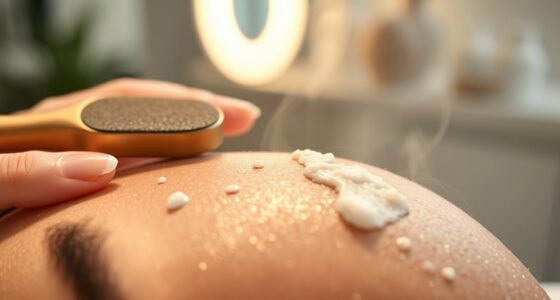Stylists often rely on silicones to give hair a sleek, shiny, and manageable look, but they don’t always share the full secret: when used properly, lightweight, water-soluble silicones protect and smooth hair without causing buildup. If applied mainly on mid-lengths and ends, and paired with regular clarifying shampoos, silicones can enhance shine without weighing hair down. Keep listening to learn how to master their use for the best results.
Key Takeaways
- Many stylists use lightweight, water-soluble silicones for a natural shine without buildup, a trick often hidden from clients.
- Proper application focuses on mid-lengths and ends, preventing greasy roots and maintaining volume.
- Regularly incorporating clarifying shampoos is essential to remove silicone residue and keep hair healthy.
- Combining silicones with natural oils can enhance shine while reducing buildup risks.
- The secret is moderation: using silicones strategically prevents dullness and damage over time.
What Are Silicones and How Do They Work on Hair
Have you ever wondered what makes your silicone-based hair products so effective? It’s the silicones that do the magic. These synthetic polymers, often ending in ‘-cone’ or ‘-oxane,’ form a thin, waterproof coating on your hair strands. Silicones work by sitting on the surface of your hair, reducing friction and smoothing the cuticles. This reflective coating boosts your hair’s shine and makes it feel softer. Importantly, silicones don’t penetrate the hair shaft or change your hair’s internal structure. They help seal in moisture, protecting your hair against heat damage and frizz without altering its natural texture. Different types of silicones vary in how easily they rinse out, but their primary role remains to enhance moisture retention and give your hair a sleek, polished look.
The Different Types of Silicones in Hair Products
Understanding the different types of silicones helps you choose the right hair products for your needs. Water-soluble silicones rinse out easily, while insoluble ones can cause buildup without proper cleansing. Volatile silicones evaporate quickly, giving you lightweight styling without residue. Additionally, some silicones are used in hair care formulations to provide long-lasting shine and smoothness. Recognizing the different silicone formulations can also help you select products that suit your hair type and styling preferences. Being aware of efficiency and sustainability in silicone use can guide you toward more eco-friendly hair care choices. Moreover, understanding the potential buildup associated with insoluble silicones can help you maintain healthy hair with proper cleansing routines.
Water-Soluble Silicones Explained
Water-soluble silicones, such as PEG-12 dimethicone and cyclopentasiloxane, are designed to dissolve easily in water, making them easy to rinse out with regular shampoo. Because of this, they’re less likely to cause buildup on your hair or scalp, unlike insoluble silicones. These silicones create a lightweight coating that adds shine, smoothness, and frizz control without weighing down fine or oily hair. They’re chemically modified for water compatibility, forming protective films that improve manageability and gloss. Since they wash out easily, water-soluble silicones are suitable for frequent use and clarifying routines, helping you maintain healthy hair over time without the need for harsh shampoos. This makes them a popular choice for those seeking effective, easy-to-remove styling benefits. Additionally, their compatibility with gentle cleansing products allows for a more balanced hair care routine that supports overall scalp health. Understanding the chemistry of silicones can empower you to choose products that work harmoniously with your hair type and styling needs. Moreover, because they are less likely to cause buildup, water-soluble silicones can help prevent the accumulation of residues that might otherwise weigh hair down or dull its appearance. Regular use of water-soluble silicones can also contribute to a more environmentally friendly hair care routine, as they typically break down more readily in water.
Insoluble Silicones and Buildup
Insoluble silicones like dimethicone, amodimethicone, and stearyl dimethicone don’t dissolve in water, so they tend to build up on your hair with repeated use. This buildup forms a persistent film that traps dirt, oils, and product residues, weighing hair down and dulling its shine. Unlike water-soluble silicones, insoluble types require strong clarifying shampoos to remove residue effectively. If you neglect proper cleansing, continued use can make your strands feel brittle, dull, and more prone to breakage over time. Understanding product formulation can help you choose hair care products that minimize buildup and maintain hair health. Being aware of silicone types can help prevent unnecessary damage and improve your hair’s appearance. Additionally, knowing the application methods of silicones can influence how effectively they are distributed and how much buildup occurs. To better understand, here’s a comparison:
| Silicone Type | Solubility | Main Effect on Hair |
|---|---|---|
| Insoluble | Does not dissolve | Causes buildup, weighs hair down |
| Water-soluble | Dissolves in water | Easier to wash out, less buildup |
Volatile Silicones for Styling
Have you ever noticed how some hair products feel light and silky without leaving any sticky residue? That’s thanks to volatile silicones like cyclopentasiloxane and cyclohexasiloxane. They evaporate quickly after application, leaving your hair smooth and glossy without buildup. These silicones help distribute styling products evenly and prevent hair from feeling greasy. Because they evaporate fast, volatile silicones also provide excellent thermal protection during heat styling by forming a temporary barrier against high temperatures. This makes them ideal in leave-in conditioners and serums, giving your hair a sleek finish while safeguarding against damage. Their lightweight nature ensures your hair remains voluminous and shiny without feeling weighed down, making volatile silicones a favorite among stylists for quick-drying, effective styling.
Why Silicones Became a Staple in Hair Care Routines
Since their introduction in the 1970s, silicones quickly became essential in hair care because they deliver immediate shine, smoothness, and frizz control. You’ll notice how silicones form a thin, protective film around each hair strand, enhancing manageability and making detangling easier. This film also acts as a waterproof barrier, shielding your hair from heat damage during styling and environmental humidity. This protective layer helps maintain moisture balance, preventing excessive dryness or oiliness. Additionally, the stability and chemical properties of silicones contribute to their long-lasting effects on hair, making them a popular choice among formulators and stylists. Formulators favor silicones because they’re stable, non-irritating, and effective even at low concentrations, making your products more efficient and long-lasting. Plus, the versatility of different silicone types—water-soluble, volatile, and insoluble—allows professionals to customize solutions for various hair textures and needs. Understanding the chemical stability of silicones can help in selecting the right formulation for specific hair care goals. Additionally, their microprocessor-based formulation ensures consistent performance across products and batch variations. It’s no wonder silicones have become a staple in countless hair routines worldwide.
Common Myths About Silicones Debunked
While silicones are widely used for their ability to boost shine, smoothness, and manageability, many myths about their effects persist. You might have heard that silicones dry out hair or clog pores, but these myths are false. Scientific studies confirm that silicones sit on the surface of your hair without penetrating or causing damage. Water-soluble and volatile silicones rinse out easily, preventing buildup and residue. Proper cleansing routines and product choices also dispel the myth that silicones are hard to remove or harmful long-term. Additionally, understanding the state tax implications for IRA withdrawals can help you make more informed financial decisions related to retirement planning. Furthermore, modern formulations are designed to minimize potential buildup, ensuring that hair remains healthy and lightweight. Advances in hair care technology have improved the safety and efficacy of silicone-based products, making them more suitable for everyday use. They are formulated to prevent long-term damage, so when used correctly, silicones do not cause harm. Silicones do not cause long-term damage or toxicity when used correctly. They don’t dry out hair or clog pores, as they stay on the surface. They improve manageability and shine without harming scalp health.
The Scientific Evidence Supporting Silicones’ Benefits
Scientific studies consistently show that silicones form a thin, protective coating on hair fibers, which reduces friction and minimizes breakage. These compounds enhance your hair’s shine, manageability, and smoothness without altering its internal structure or bonds. Research confirms that silicones do not clog pores or irritate the scalp, making them safe for most skin types. Additionally, laboratory tests reveal silicones offer effective thermal protection during heat styling by creating a heat-resistant barrier. Water-soluble silicones rinse out easily, preventing buildup, while insoluble types need clarifying shampoos for removal. This scientific evidence highlights how silicones improve hair health and appearance, giving you smoother, shinier hair with added protection—without compromising scalp or hair integrity.
How Silicones Affect Various Hair Textures and Conditions
Silicones can work differently depending on your hair type, so choosing the right kind makes all the difference. Fine or thin hair needs lightweight or water-soluble silicones to avoid greasiness, while thick, curly, or coarse hair benefits from silicones that smooth and define curls. Damaged or color-treated hair responds well to silicones that seal cuticles and restore softness, helping prevent further damage.
Fine Hair Considerations
Fine hair tends to get weighed down and look greasy when heavy, non-water-soluble silicones like dimethicone are used, which can flatten your natural volume. To keep your fine hair looking fresh and full, opt for lightweight, water-soluble silicones such as cyclopentasiloxane. These provide shine and frizz control without sacrificing your hair’s natural bounce. Applying silicones mainly to mid-lengths and ends helps prevent buildup at the roots, maintaining a light, airy feel.
- Choose water-soluble silicones to avoid greasiness and volume loss
- Limit silicone use to mid-lengths and ends for a natural look
- Regular clarifying shampoos are key to removing residue and preserving bounce
Curly and Coarse Benefits
When you have curly or coarse hair, silicones can be a game-changer by forming a flexible, water-resistant coating that locks in moisture and enhances curl definition. Silicones like dimethicone and amodimethicone help improve curl enhancement by promoting better curl clumping and reducing frizz. They smooth and straighten coarse hair by sealing cuticles and lowering surface friction, making your hair more manageable. Non-water-soluble silicones create a barrier that blocks humidity, preventing puffiness and excessive frizz typical in curly and coarse textures. Regular use of silicone serums or leave-in conditioners can restore softness and shine, especially if your hair’s been damaged or chemically treated. To avoid buildup, incorporate periodic clarifying shampoos, and opt for lightweight formulas to keep your curls bouncy and vibrant.
Damaged Hair Repair
For damaged hair, silicones act as a protective barrier that helps seal gaps in the cuticle and reduce moisture loss. This barrier smooths rough, porous strands, restoring softness and manageability. Silicones like amodimethicone are especially effective on chemically or heat-damaged hair, diminishing frizz and improving texture without further weakening strands. However, overusing silicones without regular clarifying shampoos can cause buildup, blocking moisture penetration and prolonging damage. To maximize benefits, use silicone-rich conditioners and serums strategically. Balance application to avoid weighing down fragile hair. Proper routine management, including periodic deep cleansing, ensures silicones support damaged hair without causing dryness or dullness over time.
- Restores surface integrity for damaged hair
- Prevents moisture loss and breakage
- Requires balanced use for ideal repair
The Risks of Buildup and How to Prevent It
Silicone buildup can seriously damage your hair if left unchecked, causing it to look dull, weighed down, and lifeless. When non-water-soluble silicones accumulate, they block the hair cuticle, preventing moisture from penetrating and making your strands brittle over time. Regular use of clarifying shampoos containing sulfates or silicone-removing agents helps prevent this buildup by effectively cleansing away excess residues. If you overapply silicone products without proper cleansing, the buildup worsens, especially on fine or oily hair, leading to increased dullness and heaviness. To minimize risks, focus silicone application on mid-lengths and ends, and incorporate deep-cleansing shampoos into your routine every 2-3 weeks. Staying proactive with clarifying shampoos keeps your hair healthier and free of damaging residues.
Choosing the Right Silicone-Infused Products for Your Hair
Choosing the right silicone-infused products depends on your hair type and specific needs. If you have fine or oily hair, opt for lightweight formulas with water-soluble silicones like PEG-12 Dimethicone or cyclopentasiloxane. These are easier to remove and help prevent buildup. For damaged or thick hair, heavier silicones can provide extra moisture and protection. Avoid products containing insoluble silicones like amodimethicone, which can cause long-term residue. To maintain healthy hair, incorporate clarifying shampoos every 2-3 weeks to remove non-water-soluble silicones.
Choose lightweight, water-soluble silicones for easy cleansing and healthier hair.
- Use water-soluble silicones for easier cleansing and reduced buildup
- Match silicone types to your hair’s thickness and damage level
- Choose lightweight formulas to prevent greasiness and weigh-down
Best Practices for Using Silicones Without Causing Damage
To prevent damage from silicones, it’s vital to use them strategically and in moderation. Apply silicone-based products mainly on mid-lengths and ends, avoiding the roots to prevent heaviness and greasiness. Use clarifying shampoos every 2-3 weeks to remove buildup and keep your hair healthy. Opt for water-soluble or volatile silicones in styling products, which rinse out easily and reduce residue. Limit the amount you use; a small pea-sized amount often suffices for shine and frizz control. Regularly assess your hair’s response and adjust accordingly. This prevents over-coating, which can lead to hair damage. Remember, balancing silicone use helps maintain natural volume and softness without risking damage.
| Best Practice | Why It Matters |
|---|---|
| Apply mainly on mid-lengths and ends | Prevents roots from becoming greasy or weighed down |
| Use clarifying shampoos regularly | Removes buildup, reducing hair damage |
| Choose water-soluble silicones | Ensures easy rinsing, minimizing residue |
| Use small amounts per application | Avoids over-coating and damage |
| Adjust based on hair response | Maintains healthy, natural hair look |
Natural Alternatives and When to Avoid Silicones

Natural oils like argan, coconut, and jojoba offer effective alternatives to silicones by providing shine and moisture without the risk of buildup. These natural oils nourish your hair, enhancing its health and texture without the long-term residue that silicones can cause. You should consider avoiding silicones if you have fine, oily, or chemically treated hair, as they tend to accumulate and weigh hair down. When you choose to skip silicones, opt for cleansing shampoos with surfactants like sulfates or clarifying formulas to prevent product buildup. Moving away from silicones might initially increase frizz or dryness, but your hair will adapt and benefit from natural nourishing ingredients over time. Embracing natural alternatives helps you maintain healthier, more natural hair.
Frequently Asked Questions
Why Not to Use Silicone Hair Products?
You shouldn’t use silicone hair products because they can build up over time, weighing your hair down and making it look dull. Excessive use without regular clarifying shampoos can block moisture and nutrients from penetrating your strands, leading to dryness and damage. For fine or oily hair, silicones can cause greasiness and limpness. Heavy, non-water-soluble silicones are hard to remove, risking residue that weakens your hair and hampers styling.
Which Silicone to Avoid?
You absolutely want to avoid those sneaky, insoluble silicones like amodimethicone, dimethicone, and stearyl dimethicone—they build up faster than you can blink! Steer clear of complex names like Behenoxy dimethicone, which are tough to wash out. Check ingredient lists for PEG- or EO-, and avoid those without them. These silicones cause dullness, greasiness, and fragile hair if you don’t use proper cleansers regularly.
What Is the Best Silicone for Hair?
When you ask about the best silicone for hair, water-soluble options like cyclopentasiloxane stand out. They give your hair a smooth, shiny finish without buildup, evaporate quickly, and keep your strands light. For damaged or color-treated hair, amodimethicone offers targeted coating and softness. If your hair is fine or oily, lightweight silicones prevent heaviness. Look for products with a mix of volatile and stable silicones for the best protection and manageability.
What Are the Side Effects of Dimethicone for Hair?
When you use dimethicone in hair products, you might notice buildup that can make your hair look dull and feel heavy. If you don’t wash it out regularly, it can cause dryness, brittleness, and even clog your scalp pores. This buildup may lead to irritation and reduce volume, especially if your hair is fine or oily. To avoid these issues, use clarifying shampoos to keep your hair healthy and light.
Conclusion
By understanding how silicones coat and protect your hair like a shield of armor, you can enjoy their benefits without the downsides. With the right products and techniques, you’ll keep your hair shiny and smooth, avoiding buildup like weeds choking a garden. Think of silicones as your secret weapon—powerful yet manageable—helping you achieve salon-quality hair at home. Embrace the science, make informed choices, and let your hair flow like a silken river.








